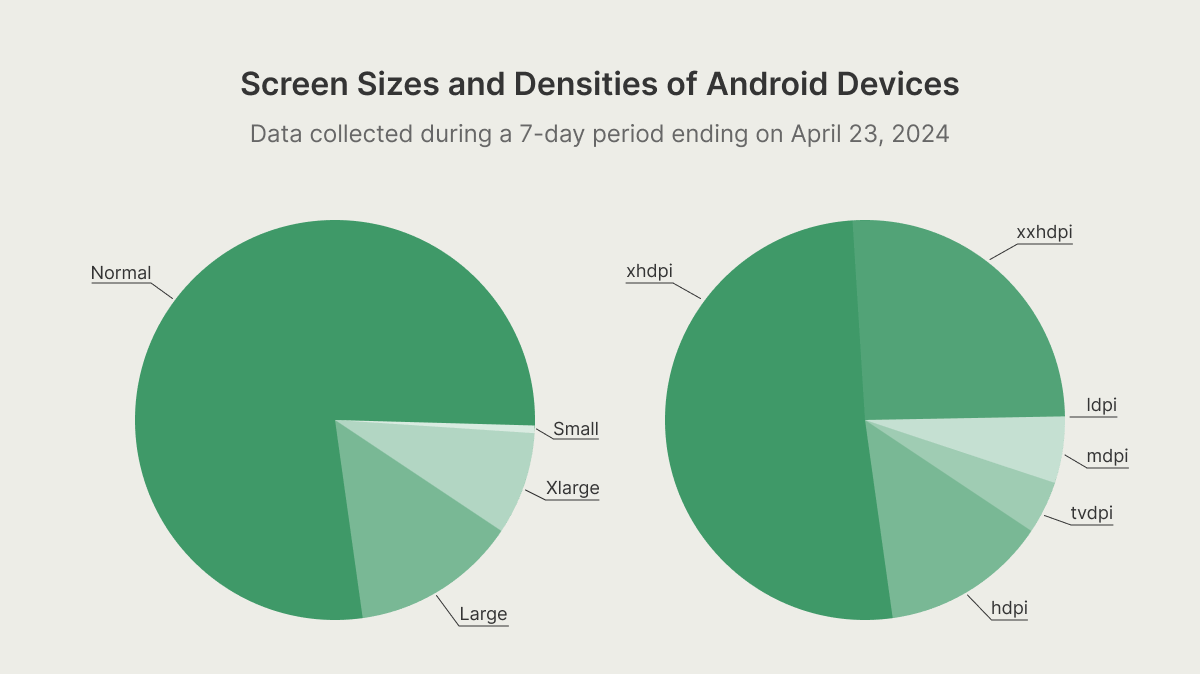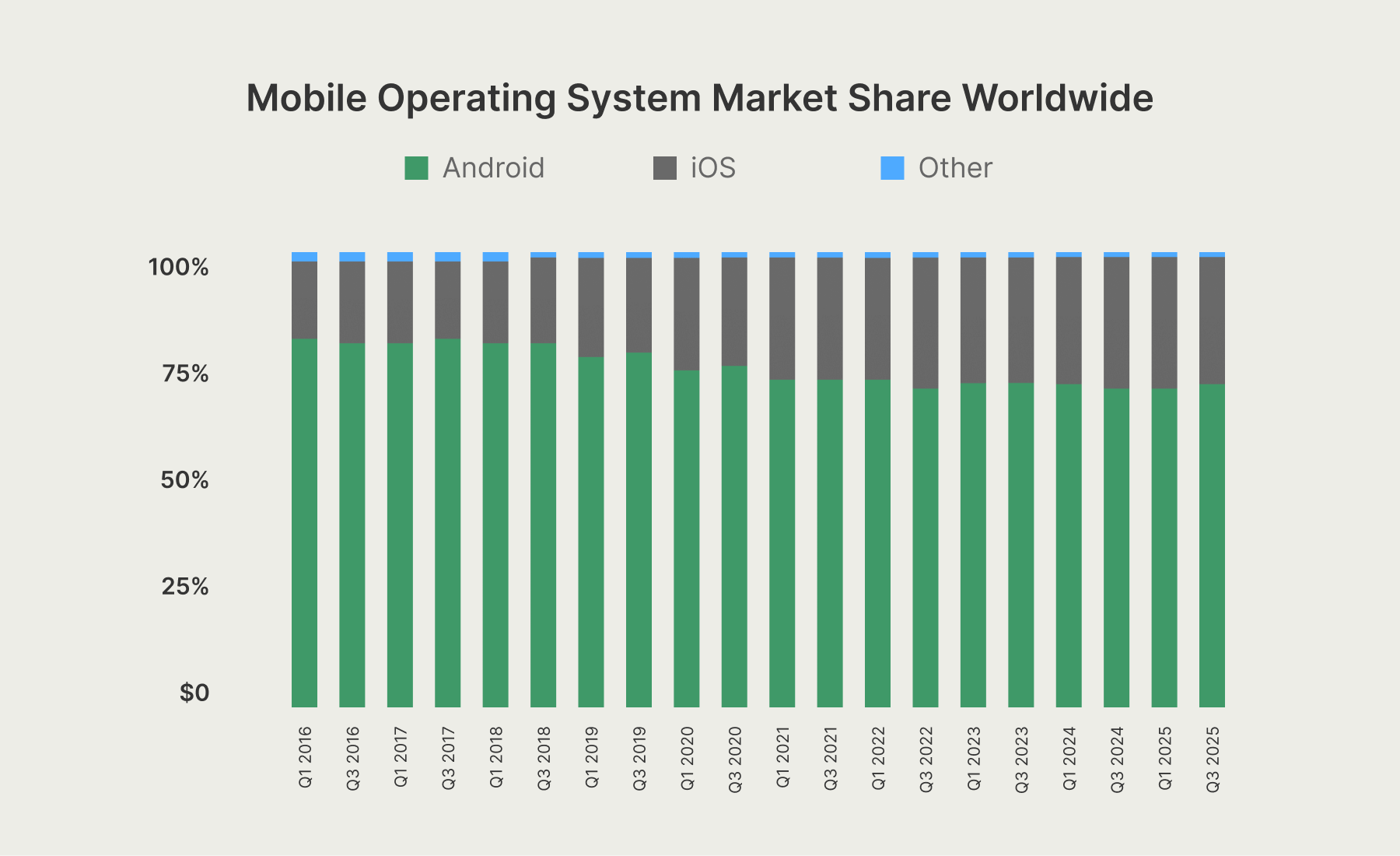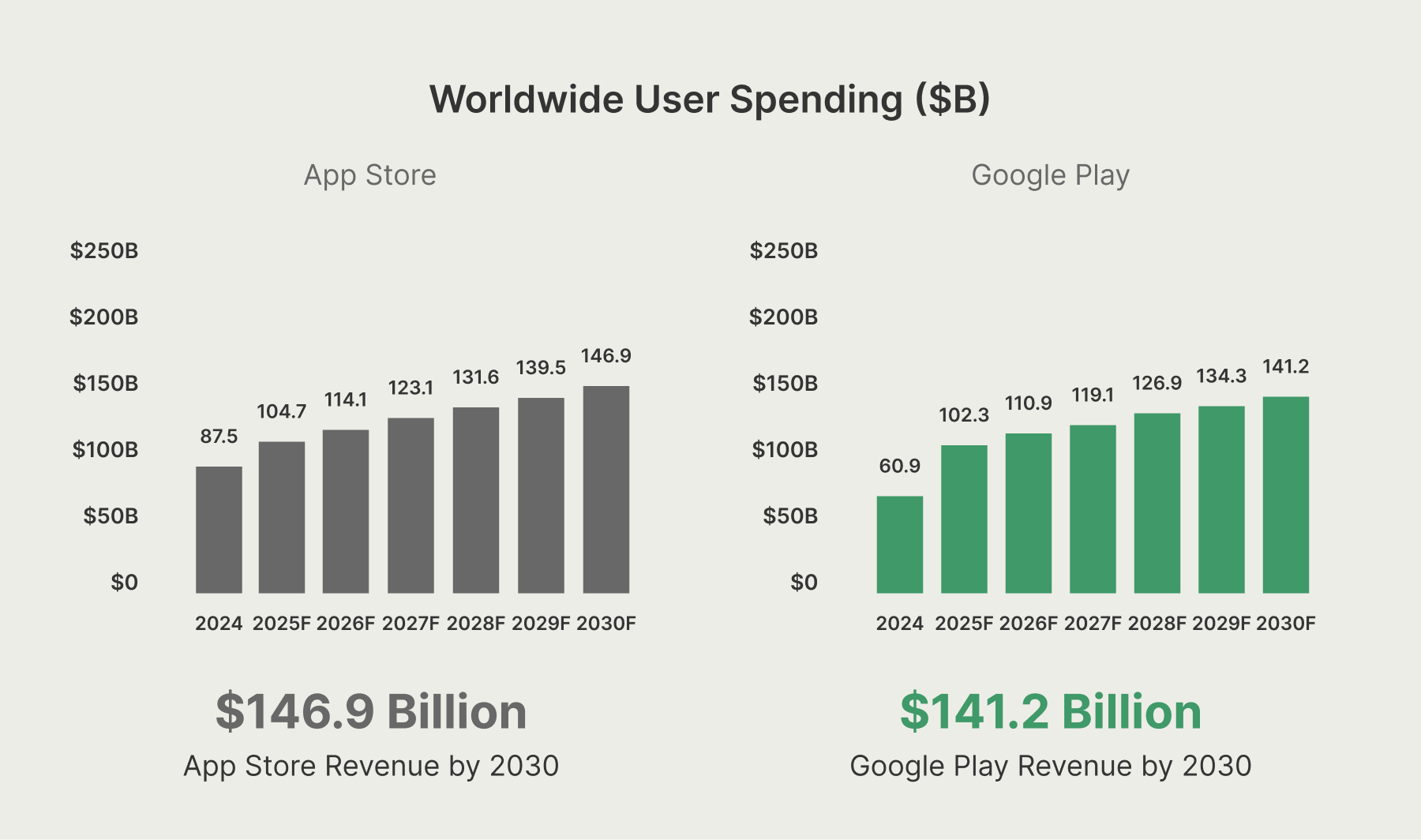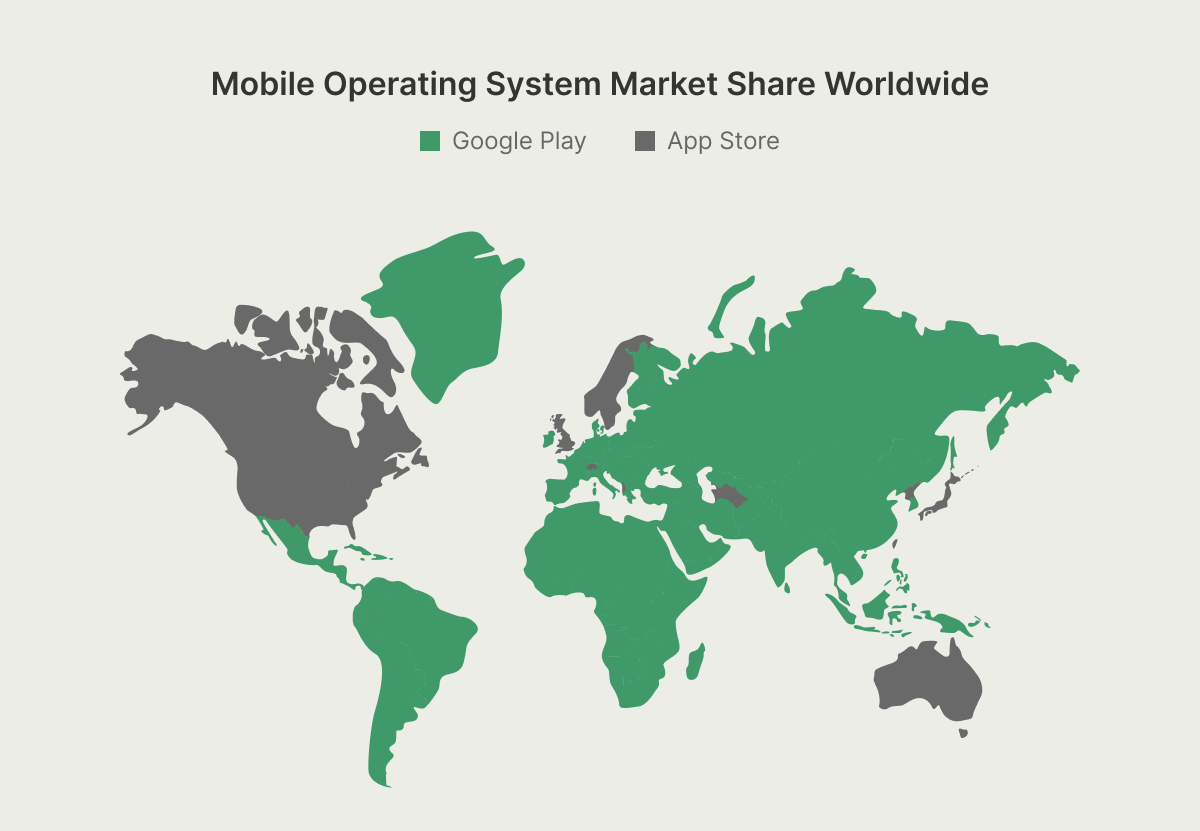The age-old clash: Android vs iOS app development? If there were a definite answer to the question, half the internet’s tech blogs would be out of a job. Here are our two cents on the topic of Android and iOS development, based on insights from our mobile development team with extensive platform experience.
Key takeaways
- There's no easy answer to the iOS vs Android app development dilemma, as the choice depends on your target audience, business model, and overall product strategy.
- iOS is ideal for premium markets, in-app purchases, and consistent UI across devices.
- Android offers a wider global reach, greater customization, and faster market entry.
- For speed and flexibility, cross-platform development is a solid option to test both ecosystems.
Option #1: Android app development
Android is an open-source mobile operating system created by Google. With an estimated 3.3 billion Android phone users, Android is considered to be the leading mobile operating system worldwide, with a vast ecosystem of Android-based devices. Google Play, the official Android app marketplace, lists over 2.6 million apps.
The benefits of developing for Android
The sheer number of Android applications is not the only advantage of this platform. Below, you can find the main differentiators of Android apps.
Flexibility
Android's open source nature offers a lot of flexibility to developers in terms of app customization. Since Google builds Android on the Android Open Source Project (AOSP), anyone can use, modify, and distribute the AOSP code and run it on hardware without licensing fees.
Android app developers can build custom launchers, widgets, and overlays - and also fine-tune features for a wide variety of hardware, including automotive systems, TVs, and wearables. This also means companies can build a single Android app that operates across a range of devices, from budget phones from 2018 to foldables from 2025, infotainment systems, and tablets, with UI and features adapting to the device's capabilities and OS versions.
Global, diverse audience
Not just the number of users, but the device diversity allows companies to tap into different market segments. Android distribution spans different regions and demographics, including emerging markets such as Asia, Africa, and Latin America. Additionally, Android apps can be easily localized for different languages, currencies, and regional features, which makes Android a safe choice for international business expansion.
Rich design
Although this advantage may create roadblocks for inexperienced app developers, the good old Material Design standards provide layered, dynamic designs with custom animations. Moreover, Google's Android Studio offers a vast collection of layouts and templates, paired with a huge library of community resources, to help Android developers prototype fast and build complex designs without starting from scratch.
Developers can also customize Material Design components or create entirely new, complicated components while still adhering to best practices. Out-of-the-box accessibility, motion-based interactions, and other features are easy to implement across Android devices.
Mature ecosystem
Developing Android apps means tapping into proven developer tools and libraries, like Android Studio (the official integrated development environment), Material Design, and Jetpack libraries. More importantly, this ecosystem is stable. Whenever Google drops updates for Android, many of the APIs remain backward-compatible with earlier versions.
Faster release
Google Play Store tends to have a less stringent approach to the submission and approval procedures. If your application doesn't violate the store's guidelines, it generally takes editors two to three days to review your submission. However, for apps with sensitive content or those published by new developers, the review timeline can be longer.
The drawbacks of Android development
Despite the many benefits, Android app development presents unique challenges.
Screen size fragmentation
A rich ecosystem of devices is a double-edged sword. While it may help extend your reach, a wide device range also requires you to adjust your application to different screen sizes, resolutions, and aspect ratios.

Quality assurance and maintenance
Each Android device brand can implement system integrations in a different way, which may translate to device-specific errors. To prevent such bugs from cropping up, developers spend extra time not just validating the app, but also testing for hardware variations in performance, sensors, RAM, and other characteristics - across low-end, mid-range, and high-end devices.
Cost of development
Because it takes longer to build, test, and optimize apps for different devices, Android app development can take more time and resources. At Orangesoft, we handle device fragmentation by prioritizing devices to test. This approach allows our developers to focus on devices and Android OS versions most popular with the app's target audience.
Option #2: iOS app development
Apple devices are not as numerous as Android ones: the number of active iPhones is about 2.2 billion. But despite having fewer users, if you develop iOS apps, you're in for some perks.
The benefits of iOS app development
Below, you'll find the main benefits of using Apple as your target platform.
Revenue
In H1 2025, out of the nearly $81 billion in total consumer spending across the two platforms, iOS accounted for just over $56 billion, meaning more than two out of every three dollars spent go to Apple's platform. App owners can leverage this tendency and use the freemium app monetization model instead of cluttering the application with ads.
The number of devices
Less is more, especially when it comes to the number of devices you have to optimize your app for. As iOS only powers Apple products, your application only needs to be adjusted for a limited and definite number of screens and devices.
Consistent user experience
If you're aiming for a uniform, consistent iOS design, this ecosystem will keep your UI/UX team within the bounds of conciseness. Apple's human interface guidelines take their origin in the flat design that makes iOS look and feel stand out among the rest.
Apple's designs revolve around clarity, simplicity, and minimalism, supported by consistent experiences across all iOS devices. Additionally, total cohesion between software and hardware results in a better user experience, as your design will be consistent across all devices.
Closed-source ecosystem
The iOS platform is classified as a closed ecosystem, as Apple has complete control over both the software and the hardware. While it can have its drawbacks, proprietary software code has a lower chance of being compromised, and this sets higher standards compared to the open-source ecosystem.
Lately, Apple has allowed EU users to install apps using alternative app stores, enabling developers to distribute their apps on AltStore, Aptoide, and other third-party marketplaces.
The drawbacks of iOS development
Despite its benefits, Apple devices can set some limits on your project. Below, you’ll find the main drawbacks.
Limited customization
Sleek, flawless, and uniform designs are the hallmark of iOS apps. However, the uniformity of designs comes from the restricted ability to customize iOS app interfaces. Moreover, it can be difficult to add third-party integrations when needed.
App release
The Apple App Store notoriously has high publishing standards for iOS apps. These requirements may delay your app launch as the marketplace may reject your app for inappropriate content, private APIs, or any other guideline violations. Every app update, app bundle, in-app purchase, or in-app event goes through a rigorous review process.
iOS vs. Android app development comparison: Who wins the battle?
Android has the edge over iOS by the number of users. As of September 2025, the Android operating system holds 73.9% of the market share, while iOS accounts for around 25.7% of the mobile market.

However, market dominance isn't the only data point to think of when choosing between iOS and Android app development.
Monetization
While the global cumulative spending on mobile apps is poised for gradual growth from 2023 to 2030, Google Play and the App Store will be chipping in to that growth in their own ways.
The App Store is expected to rake in more revenue with a projected $147 billion at an annual growth rate of 7.3%. Google Play will account for $141 billion in profit, with 7.2% annual growth, by 2030.

When it comes to downloads, the distribution is different. Google Play is expected to reach 297.4 billion downloads, while the App Store will reach 49.2 billion downloads by 2030.
Bottom line, both iOS and Android are expected to see steady demand, but in different ways. Android is and will be more about volume-driven growth — more downloads and opportunities for app distribution like alternative app stores. The iOS ecosystem will remain more fit for premium-based business models.
So it really comes down to what matters the most for a specific app product. If your main revenue stream is based on a free download with in-app purchases, iOS will give you more opportunities to make a profit since iOS users spend more. Plus, paid apps are more popular with iOS users.
If, however, your strategy is built around user reach and/or ad-based monetization, Android will be a better fit for your business model.
Target audience
If you're looking to reach a global audience, Android is probably your best bet, as most countries favor Android over iOS. In addition, up-and-coming regions like Asia prefer Android over iOS.
At the same time, North America, Australia, and northern Europe prefer Apple devices over Android. In the US, the iPhone user base overtakes Android, claiming more than half of the market in 2024. Therefore, if you're targeting the American market, iOS is your best bet.

Budget and time for development
The development timeline can also be a deal breaker when developing for either iOS or Android. However, in our experience, the development speed is roughly the same in both cases.
However, the timeline can vary based on your application's complexity, compatibility goals, and feature set. For instance, an Android project may take longer due to the operating system release cycles, Android fragmentation, and device-specific issues.
Resource-intensive Android development can also be more expensive compared with iOS, provided you're developing for a wide range of devices. But it helps to keep in mind that costs and time depend on your unique project needs.
Post-launch maintenance
After the release, your application will need a regular maintenance regimen to keep up its performance. Based on our experience, the Android platform is more likely to cause maintenance challenges due to the variety of manufacturers.
The iOS ecosystem is more consistent as it has the same hardware and operating system manufacturer. This results in more consistent quality across devices, as the manufacturer has complete control over all parts of the iOS platform.
Desired features
The set of core features, design flexibility, and overall freedom for creativity are also among the main criteria when developing for Android vs. iOS. As Android is open-source, it allows for granular customization capabilities, while on iOS, it’s far more time-intensive to go beyond uniform design elements.
Besides a wide range of hardware and manufacturers, Android offers a larger variety of features compared to Apple. For example, your Android app can include multiple payment methods, while iOS payment gateways are limited to Apple Pay.
While the iOS operating system is under the complete dominion of the Apple ecosystem, Android allows you to go Google-free. Thus, you can replace the default firmware with a custom ROM to create your version of Android and add unique features that are off-limits in stock Android.
Publishing on the app store
Although Google Play has high demands for newly submitted applications, app publishers have higher odds of getting their applications approved. The App Store tends to reject more applications straight out of the gate for the sake of higher privacy and app quality. In 2024, the App Store rejected over 139,000 developer enrollments, preventing fraudulent apps from making it to the App Store in the first place.
In response to growing frustration, Apple has streamlined its submission process to be faster and more straightforward. According to Apple, 90% of submissions are reviewed in less than 24 hours. Also, iOS developers now have direct access to Apple experts via Ask Apple.
To enter either app store, you need to purchase a developer license. While the Play Store's license is a one-time $25 fee, Apple's Developer Program annual fee is $99 and is charged annually.
User engagement
As for user engagement with in-app content, the average time spent on mobile averaged 3.5 hours a day in both markets. Therefore, both platforms suggest an equal potential for meaningful user interaction.
So, which to go with first: iOS or Android apps?
The Android vs. iOS app development dilemma boils down to a well-defined understanding of your project. Your app’s target audience, budget, monetization potential, and desired customization level contribute to your platform decision.
Android application development is the ideal choice when:
- You want to reach a wider audience;
- You need a high level of design customization and unique features;
- You want to launch the app faster.
You should consider iOS mobile app development when:
- The majority of your target users are located in wealthier regions, like Northern Europe, North America, or Australia;
- You have chosen a premium monetization model and/or intend to include in-app purchases;
- You prefer a sleek yet predictable design.
In any case, we recommend making this important choice based on your unique project needs. Also, you can always start small by building an app for just one platform to test the waters and collect actionable feedback to further iterate on your application.
You can also opt for cross-platform development to test both markets and then double down on the platform that shows the most traction.
If you're looking for a trusted app development partner — native, cross-platform, or both — Orangesoft is ready to solve your project's challenges. Reach out to us, and we can help you enter the right market with the right solution.
